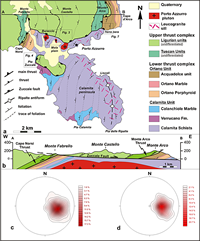The Zuccale Fault, Elba Island, Italy: A new perspective from fault architecture
Musumeci G., F. Mazzarini and A. R. Cruden (2015).
Tectonics, Volume 34, Issue 6, Pages 1195-1218, doi:10.1002/2014TC003809.
Abstract
The Zuccale Fault, central-eastern Elba Island, has been regarded since the 1990s as a low-angle normal fault that records Neogene crustal extension in the inner (Tyrrhenian side) portion of the northern Apennines. The flat-lying attitude of the fault zone and the strong excision of thick nappes were the main reasons for this interpretation. Previous structural and petrographic studies have focused primarily on the fault rocks themselves without map-scale investigation of the structural setting and deformation structures in the hanging wall and footwall blocks. Furthermore, despite the complex history proposed for the Zuccale Fault, the timing of deformation has not yet been constrained by radiometric age data. We present the findings of recent geological studies on eastern Elba Island that provide significant new insight on the nature and tectonic significance of the Zuccale Fault. We document in detail the architecture of breccias and cataclasites that comprise the Zuccale Fault. Our new observations are consistent with a purely brittle deformation zone that crosscuts older early-middle and late Miocene regional and local tectonic structures. The activity on the fault postdates emplacement of the late Miocene Porto Azzurro pluton, and it displaces a previously formed nappe stack ~6 km eastward without any footwall exhumation or hanging wall block rotation. These new data raise questions about the development of misoriented faults in the upper crust.
http://onlinelibrary.wiley.com/doi/10.1002/2014TC003809/full


